When it comes to home improvements, knowing what you want is the easy part. The tougher question is figuring out how much you can afford.
Follow this four-step plan to arrive at the answer.
1. Ballpark the Costs
First, get a handle on how much your remodeling dreams will cost. In general, major upgrades, such as a bathroom remodel or a family-room addition, run $100 to $200 and more per square foot. If you'll be using a design pro or remodeling contractor, discuss your project with them to get a rough idea of costs.
2. Figure Out How Much You Have to Spend
Once you've zeroed in on a project, the next question is whether you have the money. If you're paying cash, that's easy to answer. But if you're borrowing, you need to assess how much a bank will lend you and what that loan will add to your monthly expenses.
There are three basic types of loan options:
- A cash-out refinance
- A home equity loan
- A home equity line of credit (HELOC)
For the vast majority of homeowners, the best way to borrow for a home improvement is a home equity line of credit. A HELOC is a loan that's secured by your home equity, which means that it qualifies for a lower rate than other loan types, and you can deduct the interest on your taxes.
Because a HELOC is a line of credit rather than a lump-sum loan, it comes with a checkbook that you use to withdraw money as needed, up to the maximum amount of the loan.
For help shopping for a HELOC, download our free worksheet.
The catch is that the minimum payment on a HELOC is just that month's interest; you're not required to pay back any principal. Like only paying the minimum due on a credit card, that's a recipe for getting stuck in debt.
Instead, establish your own repayment schedule. You can do this by paying 1/60th of the principal (for a five-year pay down) or 1/120th (for 10 years) in addition to the monthly interest. If you can't afford that much, then you should reconsider your project.
Related: 6 Ways to Pay for a Remodel When You Can't Tap Home Equity
3. Get Quotes from Contractors
Before seeking bids, determine exactly what you want, right down to the kitchen countertop material and the type of faucet. By specifying these details up front, you ensure that prospective contractors are all pricing the same items.
Get recommendations for at least three contractors from friends, neighbors, and other tradesmen who you trust. Give each one your project description and specific product lists and request an itemized bid. To find the right contractor:
- Ask to see their recent work
- Check references
- Look at online sites that provide peer reviews of contractors
Related: 5 Essential Questions to Ask Before Hiring a Contractor
Reality Check: Cost Overruns
Take the winning contractor's bid and add a 15% to 20% contingency for the unforeseen problems and changes that occur on every project. Is the total still within your ability to pay? If so, you're ready to get started. If not, it's time to scale back your plans.
4. Set Priorities and Trim the Project to Fit Your Budget
Dreams and budget not in alignment? Carefully scale down your dream -- chances are you'll end up satisfied and solvent. Enlist your contractor for suggestions on cutting costs -- that way, he'll be an ally in helping you stick to your budget.
Possibilities include:
Low-cost alternatives. For example, specify laminate countertops instead of granite.
Keeping older items that are still in working condition. Appliances, furnaces, and lighting fixtures can be upgraded later.
Making the project smaller. Trim that bathroom addition from 100 square feet to 80 square feet.
Buy it yourself. You'll save up to 20% on your project costs if you buy materials and appliances yourself. Be sure to coordinate your BIY efforts with your contractor.
